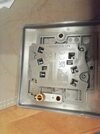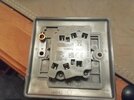I am changing my white plastic light switches to antique brass. I took one off, ensuring everything was labelled. On the old switch both com terminals were at the top, L1 and L2 bottom. On this new one (BG). One of the switches has com at top the other com at bottom. I wired as the old, live to com and switched to L1, but it seems to be upside-down. Switch up for on, down for off. Can I just turn switch upside down, or just wire live to L1 and switched live to com, or would moving switched live to L2 do the same. (oddly L1 and L2 labelled as L11 and L12!!!!) The writing inside is the right way up....
You are using an out of date browser. It may not display this or other websites correctly.
You should upgrade or use an alternative browser.
You should upgrade or use an alternative browser.
Light switch upside-down
- Thread starter chumley0312
- Start date
Sponsored Links
Yes, if there are no marks on the face.Can I just turn switch upside down,
No, that will make no difference.or just wire live to L1 and switched live to com,
Yes, that's the way to do it.or would moving switched live to L2 do the same.
COM1, L11 and L12 is one switch and(oddly L1 and L2 labelled as L11 and L12!!!!) The writing inside is the right way up....
COM2, L21 and L22 is the other.
Move the wire from L11 to L12 and the wire from L21 to L22,
Last edited:
?
Sponsored Links
Is that better?
Cheers mate. Sorry if I sound like I'm a bit dim. Will move wires. Why do BG make this so difficult.
To keep electricians in employment!. Why do BG make this so difficult.
Of course
- Joined
- 27 Jan 2008
- Messages
- 24,901
- Reaction score
- 2,877
- Location
- Llanfair Caereinion, Nr Welshpool
- Country

With large isolator's always down is off, so anything falling on them will switch them off not on. All MCB's down is off, all RCBO's down is off, it is a safety thing.
I have never understood why light switches and socket switches are the wrong way up? But many of mine are push on and push off, so can't be wrong way around. As you have found swapping L1 to L2 will swap which is up or down, but with two way switches both up or both down should be off, but since you can't see both switches at the same time, they can be either way around. So why does it matter?
I have never understood why light switches and socket switches are the wrong way up? But many of mine are push on and push off, so can't be wrong way around. As you have found swapping L1 to L2 will swap which is up or down, but with two way switches both up or both down should be off, but since you can't see both switches at the same time, they can be either way around. So why does it matter?
You have to remember that it wasn't many years ago that nearly everything was up off & down on. As far as I was concerned the only different things being this style.With large isolator's always down is off, so anything falling on them will switch them off not on. All MCB's down is off, all RCBO's down is off, it is a safety thing.
I have never understood why light switches and socket switches are the wrong way up? But many of mine are push on and push off, so can't be wrong way around. As you have found swapping L1 to L2 will swap which is up or down, but with two way switches both up or both down should be off, but since you can't see both switches at the same time, they can be either way around. So why does it matter?
Only a few weeks ago I threw out come old MCBs down on and the Wylex fuse boxes main switch (and other makes) was down on.
I don't think there will ever be a standard for fireman switches. Or rotary isolators although the all seem to have standardised clockwise on
My understanding is that "down is on" is the traditional british way, while "down is off" is the IEC/EN "harmonised" way.With large isolator's always down is off, so anything falling on them will switch them off not on. All MCB's down is off, all RCBO's down is off, it is a safety thing.
I have never understood why light switches and socket switches are the wrong way up?
Switchgear nowadays is largely harmonised, or at least built from components designed to harmonised standards even if the assembly as a whole is country specific. Electrical acessories on the other hand are not.
Thanks for the help. To be honest it doesn't really bother me, it's SWMBO who's bothered. I'll swap the L wires this aft. I've got another 3 to change out, so at least I know what the issue is. I've been putting a small wire from the earth terminal on the switch to the earth on the back box, but one back box is a bit tight. Is it really needed, and won't the screws provide an earth?
I see you have some dreadful BG switches.
The terminals are quite large and square shaped - you may experience wires slipping out of the terminals quite easily, or just feeling loose.
You will probably need to ensure the ends of the wires are folded over, and this may even be the case if even if you have two or so wires in a terminal.
The terminals are quite large and square shaped - you may experience wires slipping out of the terminals quite easily, or just feeling loose.
You will probably need to ensure the ends of the wires are folded over, and this may even be the case if even if you have two or so wires in a terminal.
Yes.
Isolators at the mains used to be up for off and down for on but they got changed (sensibly ) to Up for on and down for off, there are still a few in existence today and some have a mixture of both types to trap the unwary.
Normal light switches are up for off and down for on if they are used in a one way configuration .
Now then, you can use 2 way switches as 1 way switches if you want.
Some manufacturers label the terminals differently.
1/ C or Com for common and the other two as L1 & L2 - but some use L1 for 1 way switching whereas others use L2.
If its just a one gang switch you could turn it upside down and it will be in the correct orientation.
2/ Some manufacturers label them as L1 (for the common) and L2 & L3 for the other two terminals.
3/ Some manufactures put ganged switches all the same orientation (say all the Coms at the top) and some alternate them.
I think they all are labelled "top" to show you the way the manufacturer wants you to orientate them.
All good fun
Isolators at the mains used to be up for off and down for on but they got changed (sensibly ) to Up for on and down for off, there are still a few in existence today and some have a mixture of both types to trap the unwary.
Normal light switches are up for off and down for on if they are used in a one way configuration .
Now then, you can use 2 way switches as 1 way switches if you want.
Some manufacturers label the terminals differently.
1/ C or Com for common and the other two as L1 & L2 - but some use L1 for 1 way switching whereas others use L2.
If its just a one gang switch you could turn it upside down and it will be in the correct orientation.
2/ Some manufacturers label them as L1 (for the common) and L2 & L3 for the other two terminals.
3/ Some manufactures put ganged switches all the same orientation (say all the Coms at the top) and some alternate them.
I think they all are labelled "top" to show you the way the manufacturer wants you to orientate them.
All good fun
Are you sure they all "got changed" and why sensibly? Surely the sensible thing is to have a standard and stick to itYes.
Isolators at the mains used to be up for off and down for on but they got changed (sensibly ) to Up for on and down for off, there are still a few in existence today and some have a mixture of both types to trap the unwary.
There are still isolators available for sale in both orientations.
Last edited:
DIYnot Local
Staff member
If you need to find a tradesperson to get your job done, please try our local search below, or if you are doing it yourself you can find suppliers local to you.
Select the supplier or trade you require, enter your location to begin your search.
Please select a service and enter a location to continue...
Are you a trade or supplier? You can create your listing free at DIYnot Local
Sponsored Links
Similar threads
- Replies
- 6
- Views
- 3K
- Replies
- 5
- Views
- 16K


